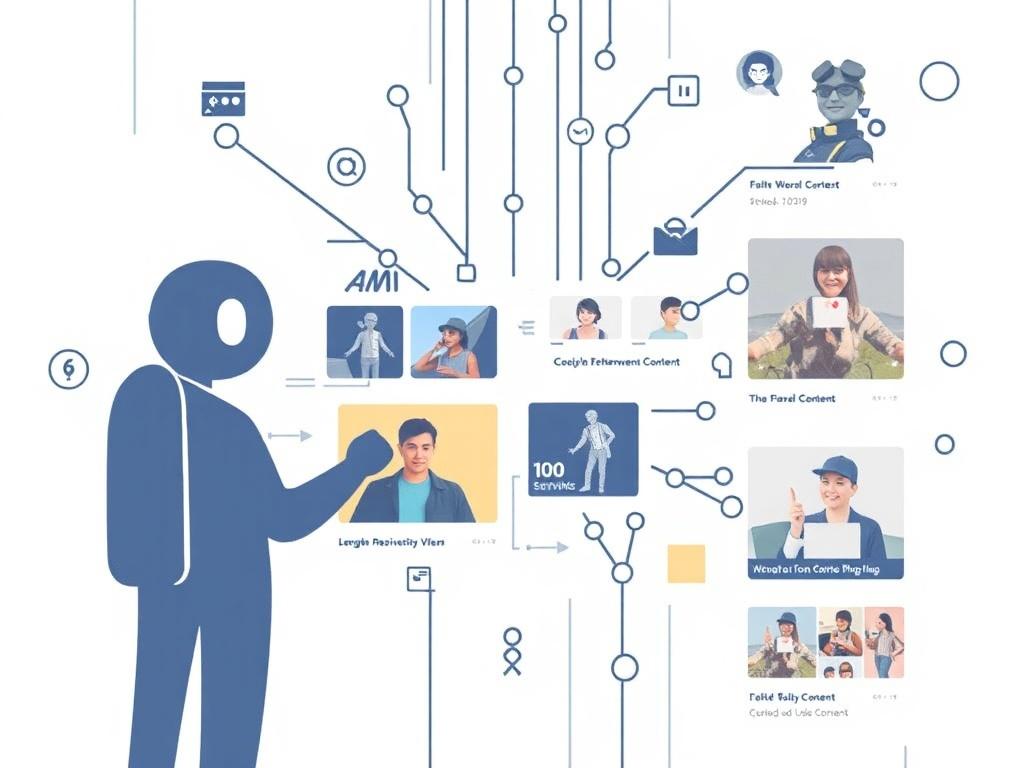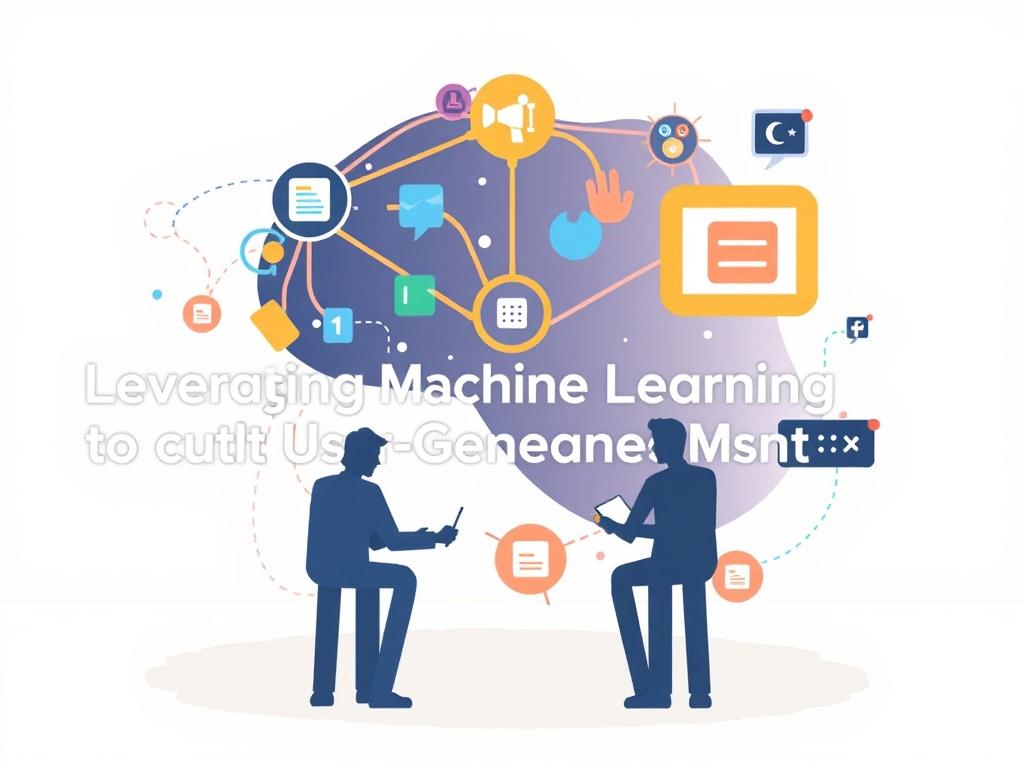Think about the last time you scrolled through a social feed, browsed community reviews, or watched a video recommended by a platform that seemed to know exactly what you wanted. Behind that seemingly effortless experience is a growing partnership between human creativity and artificial intelligence. User-generated content (UGC) is the vibrant, messy, and prolific stuff people create every day—texts, images, videos, reviews, comments, and beyond. Machine learning (ML) is the set of tools and techniques that helps platforms organize, filter, surface, and moderate that content so it’s useful rather than overwhelming.
This article walks through how AI and machine learning can be used to curate UGC effectively. We’ll dig into what UGC really is, why curation matters, what machine learning adds to the mix, practical pipelines you can adopt, metrics to measure success, pitfalls to watch out for, legal and ethical considerations, and where this field is heading. Whether you’re a product manager at a content platform, a community manager trying to keep conversations healthy, a developer building recommender systems, or simply curious about how these technologies shape the online experiences we all have, you’ll find actionable ideas and clear explanations here.
What Is User-Generated Content, and Why Does It Matter?
User-generated content (UGC) is any material—text, images, audio, video, ratings, or combinations—created and published by users rather than platforms or professional creators. The scale and diversity of UGC are staggering: consider forums, social networks, product review sections, comments on news articles, tutorial videos, livestreams, and fan art. UGC drives engagement, builds communities, and provides authentic perspectives that professional content often cannot match.
But UGC also presents challenges. The sheer volume can drown out quality; harmful or irrelevant posts can erode trust; and inconsistent metadata and formats make it hard to index, recommend, or moderate content automatically. That’s where curation comes in. Curation is the process of selecting, organizing, and presenting content so that users find value quickly and safely. Manual curation doesn’t scale. This is why machine learning has become a crucial ally—enabling platforms to sift through massive amounts of UGC, highlight what matters, and reduce friction for users.
Types of UGC You’ll Encounter
UGC comes in many forms and each type demands different curation strategies. Here’s a quick look at common categories and their curation needs.
- Text: Comments, reviews, forum posts. Needs sentiment analysis, spam detection, summarization.
- Images: Photos, memes, user art. Needs classification, similarity search, content tagging, copyright checks.
- Video: Clips, livestreams, tutorials. Needs scene detection, transcript generation, content safety filtering.
- Audio: Podcasts, voice notes. Needs speech-to-text, speaker identification, and topic classification.
- Ratings and structured feedback: Numerical scores and forms. Needs aggregation, anomaly detection.
How Machine Learning Enhances UGC Curation
Machine learning brings several capabilities to the table: automation at scale, personalization, anomaly and abuse detection, semantic understanding, and continuous learning from user signals. These capabilities let platforms turn a glut of UGC into a coherent, discoverable, and safe experience for users.
At a high level, ML helps curate UGC by:
- Filtering out spam and abusive content through classifier models.
- Extracting meaning and entities from text for better indexing and search.
- Tagging and categorizing images and videos so visual content can be recommended or moderated.
- Ranking and personalizing feeds based on predicted engagement and relevance.
- Automatically generating summaries and captions to improve accessibility and discoverability.
Core ML Techniques Used in Curation
Several machine learning techniques are commonly used in UGC curation. Understanding their strengths and trade-offs helps you design better systems.
- Supervised learning: Classification models trained on labeled examples for tasks like hate speech detection, spam classification, or sentiment analysis.
- Unsupervised learning: Clustering and topic modeling to discover themes in large corpora without labels.
- Deep learning: CNNs for images, RNNs/Transformers for text and audio, and sequence models for video understanding.
- Recommender systems: Collaborative filtering, content-based filtering, and hybrid models to personalize feeds and suggestions.
- Embedding and similarity search: Dense vector representations for semantic search and near-duplicate detection.
Designing an ML Pipeline to Curate UGC
Curating UGC with machine learning is best thought of as a pipeline rather than a single model. A pipeline breaks the problem into manageable stages, each with its own models, features, and evaluation metrics. Here’s a practical pipeline you can adapt to your platform.
Typical UGC Curation Pipeline
| Stage | Purpose | Typical Techniques | Key Metrics |
|---|---|---|---|
| Ingestion | Collect raw content and metadata | Event queues, streaming APIs, batching | Latency, throughput |
| Preprocessing | Normalize and clean text/audio/video | Text normalization, speech-to-text, video frame extraction | Error rates, processing time |
| Feature extraction | Compute embeddings and content features | Transformers, CNNs, acoustic features | Feature quality, dimensionality |
| Classification/Tagging | Detect categories, safety issues, topic labels | Supervised classifiers, multi-label models | Precision, recall, F1-score |
| Ranking/Recommendation | Score and order content for users | Learning-to-rank, collaborative filtering | CTR, dwell time, retention |
| Moderation & Enforcement | Flag, hide, or escalate problematic content | Rule engines augmented with ML signals | False positive/negative rates, response time |
| Feedback Loop | Learn from user interactions and human reviews | Online learning, periodic retraining | Model improvement metrics over time |
Breaking the system into stages makes it easier to monitor, debug, and improve. For instance, if a recommender is surfacing poor results, you can inspect the feature extraction and classification stages to locate the root cause rather than treating the system as a monolith.
Feature Engineering and Representation Matters
Features are the backbone of ML models. For UGC, features can be as simple as word n-grams or as complex as multimodal embeddings that combine text, image, and audio representations. Modern pipelines increasingly rely on pre-trained transformer models to produce high-quality embeddings that capture semantics more effectively than handcrafted features.
- Text features: TF-IDF, pre-trained language model embeddings, named entities, sentiment scores.
- Image features: Pretrained CNN embeddings, object detections, color histograms.
- Video features: Keyframe embeddings, speech transcripts, scene changes.
- User features: Historical engagement, trust score, content preferences.
- Contextual features: Time of day, device type, location signals (where allowed).
Balancing Personalization and Diversity
One of the most exciting outcomes of combining AI with UGC is personalization: you can surface the content that a particular user is most likely to find engaging. But blindly optimizing for predicted engagement can lead to filter bubbles and reduce content discovery. The goal is to balance relevance with diversity, serendipity, and fairness.
Several techniques help strike that balance. Re-ranking models can take an initial relevance score and incorporate diversity constraints. Multi-objective optimization can trade off short-term clicks versus long-term retention or user satisfaction. Bandit algorithms help explore alternative content to learn user preferences without sacrificing performance.
Practical Strategies for Diverse Feeds
- Slot-based allocation: Reserve portions of the feed for diverse or novel content.
- Determinantal point processes (DPPs): Probabilistic models that encourage diverse selection.
- Hybrid recommenders: Combine collaborative signals (what similar users liked) with content-based signals (what the content is about).
- Controlled exploration: Use contextual bandits to try new content types with users who are likely to tolerate exploration.
Moderation: Automated, Human-in-the-Loop, and Hybrid Models
Safety and trust are non-negotiable on most platforms. Automated moderation scales but makes mistakes; human moderators are skilled but overwhelmed. Hybrid models—where ML filters and triages content, and humans make final calls on edge cases—are often the most practical approach.
Automated moderation typically involves multi-stage filtering: a fast, broad classifier to remove obviously harmful content, followed by more specialized models for nuanced decisions (e.g., distinguishing satire from hate speech), and finally human review for ambiguous cases. You can also use ML to prioritize the queue of reports to make the best use of scarce human reviewer time.
Common Moderation Models and Use Cases
- Binary classifiers for blacklisted content (spam, explicit imagery).
- Multilabel classifiers for nuanced categories (harassment, bullying, misinformation).
- Sequence models that analyze conversation history to detect escalation.
- Embedding-based detectors for near-duplicate images and deepfake identification.
Metrics: How to Know If Your Curation Works
Choosing the right metrics is essential. Traditional ML metrics like accuracy, precision, recall, and AUC are useful for model validation, but product success depends on user-centric metrics. Here are important categories to monitor.
| Metric Category | Examples | Why It Matters |
|---|---|---|
| Content Quality | Moderation precision/recall, label agreement | Ensures harmful content is removed while preserving legitimate content |
| Engagement | Click-through rate (CTR), dwell time, likes/shares | Indicates how relevant and compelling the curated content is |
| Retention & Satisfaction | Daily/Monthly active users (DAU/MAU), NPS | Measures long-term value of curation strategy |
| Diversity & Fairness | Content source variety, demographic reach | Prevents echo chambers and ensures equitable exposure |
| Operational | Latency, moderation queue size | Ensures the system scales and responds quickly |
It’s important to run controlled experiments (A/B tests) when you change curation algorithms so you can measure causal impact on engagement, retention, and safety rather than correlational signals that could mislead.
Privacy, Safety, and Legal Considerations
When you work with UGC, you’re handling personal expressions and sometimes sensitive information. Regulations such as GDPR, CCPA, and others place legal requirements on data collection, retention, and user rights. But beyond compliance, designing for privacy and safety builds trust—users who trust your moderation and curation practices are more likely to engage and contribute.
Privacy-preserving techniques include data minimization, differential privacy for aggregated analytics, and on-device models that avoid sending raw content to servers. Safety also means being transparent about how content is moderated and providing clear appeal and feedback mechanisms for users who feel incorrectly flagged.
Checklist for Responsible UGC Curation
- Collect the minimum necessary user data and clearly document purposes.
- Provide users with control over their data and easy ways to request deletion or correction.
- Use human review for edge cases and enable appeal processes.
- Monitor model drift and ensure periodic retraining with recent, representative data.
- Audit models for bias and disparate impact across groups.
Practical Tooling and Platforms
There are many tools to help build ML-powered curation pipelines, ranging from cloud ML services to open-source libraries and specialized moderation platforms. Choosing the right stack depends on your engineering resources, scale, and privacy requirements.
| Use Case | Common Tools / Libraries | Notes |
|---|---|---|
| Text classification | Hugging Face Transformers, spaCy, FastText | Great starting point; pre-trained models can be fine-tuned |
| Image/video analysis | TensorFlow, PyTorch, OpenCV, MediaPipe | GPU resources may be required for training |
| Recommender systems | Implicit, LightFM, TensorFlow Recommenders | Hybrid methods perform well in practice |
| Moderation & human-in-loop | HITL platforms, Amazon Mechanical Turk, internal moderation tools | Design for safety and reviewer well-being |
| Streaming ingestion | Kafka, Kinesis, Pub/Sub | Scales ingestion and supports real-time pipelines |
Case Studies and Real-World Examples
It helps to see concrete examples of how platforms use AI to curate UGC. Here are a few simplified scenarios that illustrate common patterns.
Community Forum: Prioritizing High-Quality Answers
A question-and-answer community wants to promote helpful answers while highlighting expert contributors. They build an ML pipeline that scores answers based on textual quality (readability, completeness), author reputation (historical helpfulness), and engagement signals (upvotes, dwell time). A learning-to-rank model combines these signals to surface top answers at the top while still occasionally promoting new contributors to foster community growth. Human moderators handle policy appeals.
Social App: Balancing Personalization and Safety
A social app uses collaborative filtering to personalize feeds but layers content-safety models to filter explicit or hateful content before ranking. To prevent filter bubbles, they reserve a portion of each feed for algorithmically selected diverse content and use bandit algorithms to learn what kind of exploration improves long-term retention. The result is a safer platform that still feels personally relevant.
E-commerce Reviews: Highlighting Trustworthy Feedback
An online marketplace uses ML to detect fake reviews and surface trustworthy feedback. They use user engagement patterns, textual signals, and metadata (purchase verification) to score reviews. Reviews flagged as suspicious are deprioritized or sent for human review. Summarization models generate concise highlights to help shoppers decide quickly.
Challenges and Common Pitfalls

Despite the promise of ML, several common pitfalls can derail UGC curation projects: poor data quality, mismatched metrics, lack of continuous feedback, unintended bias, and overreliance on automation. Being aware of these pitfalls and designing for mitigation is essential.
- Insufficient labeled data: Many moderation categories are rare (e.g., certain forms of abuse), making model training difficult. Consider active learning and data augmentation.
- Model drift: Language and behavior evolve. Periodic retraining and continuous evaluation are necessary to maintain accuracy.
- False positives in moderation: Overzealous filtering can alienate legitimate users. Keep human reviewers in the loop and measure false positive rates carefully.
- Feedback loops: Personalization algorithms can amplify biases if feedback is solely based on engagement. Use counterfactual evaluation and controlled experiments.
- Scalability: Multimodal processing (video/audio) can be computationally expensive. Optimize inference and consider batching strategies.
Implementation Roadmap: From Prototype to Production
If you’re starting from scratch, here’s a pragmatic roadmap to take ML-powered UGC curation from idea to production in a manageable way.
- Define clear product goals: What problem are you solving? Better relevance, safer community, reduced moderation workload?
- Collect representative data: Ensure your dataset captures the diversity of content and edge cases.
- Build a small, focused prototype: Start with one content type (e.g., text) and one clear use case (e.g., spam detection).
- Set up human-in-the-loop: Integrate human review to label edge cases and validate model outputs.
- Iterate on models and features: Use feedback to improve precision and recall, and add multimodal features as needed.
- Instrument metrics and A/B test: Measure product-level impact and guardrails like false positive rates.
- Scale infrastructure: Move from batch experiments to streaming ingestion, optimize inference, and consider edge or on-device models where privacy matters.
- Governance and compliance: Document policies, set up appeals, and implement data retention and deletion workflows.
Future Trends: Where AI + UGC Is Headed

The intersection of AI and UGC is evolving rapidly. Several trends will shape the next phase of curation:
- More powerful multimodal models that understand text, images, audio, and video jointly, making cross-modal recommendations and more accurate moderation possible.
- On-device inference for privacy-preserving personalization, reducing the need to send raw content to centralized servers.
- Federated learning to train models across users’ devices while keeping personal data local.
- Explainable AI that can provide human-understandable reasons for why content was recommended or flagged.
- Better tools for creator attribution and rights management, helping platforms balance discoverability with respect for creators’ ownership.
How Creators Fit into the Future
Creators are not passive inputs to a curation machine; they are active participants in the ecosystem. Platforms that surface high-quality UGC while giving creators clear signals on how to improve their visibility will cultivate healthier content ecosystems. Tools that help creators tag, caption, and transcribe content not only improve discoverability but also reduce moderation friction.
Checklist: What to Build First

If you only have time to do three things now, prioritize these to make most progress quickly.
- Build a robust ingestion and preprocessing pipeline to normalize UGC and extract basic metadata and transcripts.
- Deploy a high-precision moderation model for obvious policy violations and integrate human review for edge cases.
- Implement a simple recommender that combines content relevance with signals of quality (e.g., verified purchase, author reputation) and measure its impact with an A/B test.
Measuring Long-Term Success
Short-term gains like increased clicks can be seductive, but long-term success depends on trust and sustained engagement. Track indicators like retention, user-reported satisfaction, incidence of abusive content over time, and creator health. Use cohort analysis to see how curation changes affect new versus established users, and monitor for any systematic biases that might hurt underrepresented groups.
Questions to Ask Continuously
- Are we surfacing the content users most need or just what gets the most clicks?
- How often are users appealing moderation decisions and why?
- Are certain creators or groups receiving disproportionately low visibility?
- How is the model performing on new types of content or new vernacular?
People, Process, and Culture
Technology alone won’t solve curation challenges. You need the right people, processes, and culture. Cross-functional teams—product managers, data scientists, moderators, legal counsel, and community managers—need to collaborate closely. Establish feedback loops where moderators can flag model weaknesses and where model insights inform moderation policy refinement. Invest in reviewer well-being and training; moderation work can be emotionally costly and demands robust support systems.
Also, build a culture of transparency and accountability. Publicly communicating how content is curated, what appeals processes exist, and how policies are enforced strengthens community trust and helps creators understand the ecosystem they’re contributing to.
Final Thoughts on AI and UGC
Machine learning dramatically amplifies our ability to make sense of user-generated content, but it’s not a magic wand. The best outcomes arise from pragmatic systems that combine automated models with human judgment, prioritize user trust, and keep learning over time. Whether you’re trying to scale content moderation, surface valuable creations, or build a more engaging personalized feed, the key is to start with a clear product goal, instrument the right metrics, and iterate rapidly while safeguarding privacy and fairness.
Conclusion
AI-powered curation transforms raw user-generated content from noisy, unstructured data into meaningful, discoverable, and safe experiences—but only when coupled with thoughtful design, human oversight, and strong governance. By building modular pipelines, choosing the right features and models, measuring the right outcomes, and prioritizing user trust, platforms can harness the creativity of their communities while protecting and delighting users. The future will bring more powerful multimodal and privacy-preserving techniques, and those who plan for continuous learning and transparent policies will be best positioned to benefit from the rich, messy world of UGC.
